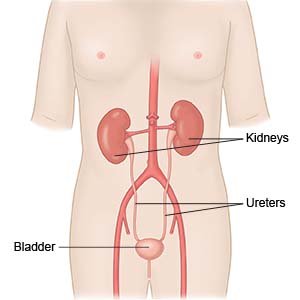Cystectomy with Continent Cutaneous Urinary Diversion
Medically reviewed by Drugs.com. Last updated on Aug 4, 2025.
Cystectomy with continent cutaneous urinary diversion is surgery to remove your bladder. Your surgeon will create a new way for urine to drain out of your body. He or she will make a new bladder from a piece of your intestine. The new bladder will be connected to an opening called a stoma on your abdomen. You will empty urine through a catheter you will guide through the stoma and into the new bladder.
 |
DISCHARGE INSTRUCTIONS:
Call your local emergency number (911 in the US) for any of the following:
- You have chest pain.
- You feel lightheaded or short of breath.
- You cough up blood.
Seek care immediately if:
- Your arm or leg feels warm, tender, and painful. It may look swollen and red.
- Blood soaks through your bandage.
Call your doctor or surgeon if:
- You have a fever.
- Your stitches or staples come apart.
- You have a fever or chills.
- You do not get urine when you catheterize the stoma.
- Your incision wound or stoma is red, swollen, or draining pus.
- You have nausea or are vomiting.
- You have questions or concerns about your condition or care.
Related medications
Medicines:
- Blood thinners help prevent blood clots. Clots can cause strokes, heart attacks, and death. Many types of blood thinners are available. Your healthcare provider will give you specific instructions for the type you are given. The following are general safety guidelines to follow while you are taking a blood thinner:
- Watch for bleeding and bruising. Watch for bleeding from your gums or nose. Watch for blood in your urine and bowel movements. Use a soft washcloth on your skin, and a soft toothbrush to brush your teeth. This can keep your skin and gums from bleeding. If you shave, use an electric shaver. Do not play contact sports.
- Tell your dentist and other healthcare providers that you take a blood thinner. Wear a bracelet or necklace that says you take this medicine.
- Do not start or stop any other medicines or supplements unless your healthcare provider tells you to. Many medicines and supplements cannot be used with blood thinners.
- Take your blood thinner exactly as prescribed by your healthcare provider. Do not skip a dose or take less than prescribed. Tell your provider right away if you forget to take your blood thinner, or if you take too much.
- Take your medicine as directed. Contact your healthcare provider if you think your medicine is not helping or if you have side effects. Tell your provider if you are allergic to any medicine. Keep a list of the medicines, vitamins, and herbs you take. Include the amounts, and when and why you take them. Bring the list or the pill bottles to follow-up visits. Carry your medicine list with you in case of an emergency.
Wound and stoma care:
- Carefully wash your incision wound and stoma. Use soap and water. Dry the area and put on new, clean bandages as directed. Change your bandages when they get wet or dirty.
- Rinse your new bladder 1 to 2 times a day with saline (salt water). This keeps your bladder clean. Ask for more information on how to care for your stoma.
Self-care:
- Rest as needed. Slowly start to do more each day. Return to your daily activities as directed.
- Use a catheter to drain your bladder. Drain your bladder every 2 hours for the first week. Drain your bladder every 3 hours for the next 6 weeks. Drain your bladder every 4 to 5 hours after 6 weeks.
- Prevent constipation. Eat foods that are high in fiber, and drink more liquids. High-fiber foods include fruits, vegetables, whole grains, and bran. This will help soften your bowel movements. Regular exercise and extra liquids may also help prevent constipation.

- Ask which activities are safe for you. Do not lift heavy objects. Ask when you can return to work, drive, or have sex. You may have problems with sex after your surgery. Talk to your healthcare provider if you have any problems or concerns.
- Do not smoke. Nicotine and other chemicals in cigarettes and cigars can cause blood vessel damage. Smoking can increase the time it takes for you to heal. Ask your healthcare provider for information if you currently smoke and need help to quit. E-cigarettes or smokeless tobacco still contain nicotine. Talk to your healthcare provider before you use these products.
Follow up with your doctor or surgeon as directed:
You will need to return to have the stents removed, and you may need more tests. You will also need to return to make sure the stoma is healing. Write down your questions so you remember to ask them during your visits.
© Copyright Merative 2025 Information is for End User's use only and may not be sold, redistributed or otherwise used for commercial purposes.
The above information is an educational aid only. It is not intended as medical advice for individual conditions or treatments. Talk to your doctor, nurse or pharmacist before following any medical regimen to see if it is safe and effective for you.
Learn more about Cystectomy with Continent Cutaneous Urinary Diversion
Care guides
Further information
Always consult your healthcare provider to ensure the information displayed on this page applies to your personal circumstances.
